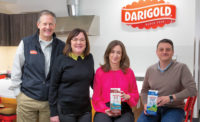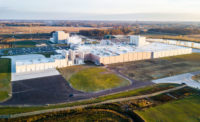Darigold’s Portland, Ore., plant is solving the puzzle
Producing over 150 SKUs, Darigold’s ultrapasteurized milk plant in Portland, Ore., has to stay flexible and organized to manage its complicated production schedules.










Some residents of Oregon’s largest city have sought to “Keep Portland Weird,” a motto based on safeguarding the city’s reputation for farmers markets, artisanal craftworks and an eccentric literary/arts scene. But before it became the de facto capital for millennial hipsters, Portland had a long history of industrial production.
Bordering the Willamette River — a short fixed-gear bike ride from downtown — is an industrial zone that includes the Portland plant of Darigold Inc., the Seattle-based corporate subsidiary of the Northwest Dairy Association cooperative (see Processor Profile). The 353,268-square-foot plant, which used to be operated by Mayflower Dairy, was built in 1944; Darigold took over the location in 1981. The age of the facility means the Portland plant staff is constantly finding ways to adapt it for contemporary production realities.
“Modifying older buildings can always be a challenge, but we’ve moved in the right direction in terms of equipment and safety,” says Kathleen Momont, production manager for Darigold’s Portland location.
Curt Hyland, plant manager, adds that while the plant might be older on the facility side, Darigold has invested in flexible operation systems to make it functional for today’s needs. And that’s essential, because this plant location produces many ultrapasteurized milk products for Darigold’s business.
Hyland says that 155 SKUs are made in the Portland plant, including flavored milk, lactose-free milks, creamers, ice cream mixes, eggnog and half & half. When Dairy Foods visited, Darigold was in the middle of its seasonal eggnog production.
Local milk
Darigold’s busy Portland location operates 24 hours a day, seven days a week. To keep it running, the plant employs nearly 150 employees, each of whom works one of three shifts.
Eduardo Estrada is one of the plant’s employees. As a receiver, he begins the milk’s production by helping unload 10 to 14 truckloads of raw milk from Oregon and southern Washington a day. This works out to 700,000 to 980,000 pounds of milk, says Hyland. (Darigold also receives cream, sugar, soy oil and other ingredients in its receiving bays.)
Before the milk is unloaded, Estrada says he performs a quality test to make sure it meets Darigold’s standards. He takes a sample of the milk and performs tests, including making sure it tastes good, is at the correct temperature and contains no antibiotics or added water. He then connects hoses to unload the tankers and using pumps, moves the milk into one of five raw bulk milk silos, which hold 40,000-60,000 gallons each, says Momont.
The milk goes from the raw bulk silos to the mix area (separator, standardizer or batch system). In the batch system, milk travels into one of four batch tanks to mix ingredients together. The milk is agitated for 10 to 15 minutes, and then a sample is taken for a flavor check. The plant uses pasteurization so that the sample is safe to consume for a test, explains Momont.
The batches that are certified go through the mix-proof valves to be pasteurized. The entire plant uses ultrapasteurization. During this step, steam is directly injected into the product, says Momont. Product is heated to 292 degrees Fahrenheit for two to four seconds. It then goes into a vacuum chamber, which removes the steam from the milk.
The final step on the raw side is when milk travels to a homogenizer, and then into the plate heat exchanger. Then, it is put into into a sterile storage tank, which supplies the fillers; it is cooled to around 39 degrees Fahrenheit before entering the filler.
If the milk is going to be made into a lactose-free product such as Darigold’s popular FIT line of high-protein, low-sugar milk, it goes through an extra step.
Momont explains the milk is made lactose-free in two different ways in the plant. One method is to put the milk into a silo with the lactase enzyme to remove the lactose. The other uses Darigold’s new aldose equipment, which is faster than the other method.
This equipment runs pasteurized milk through sterile filters before it injects the lactase enzyme into the product. The lactose reduces in the finished product tank, which saves time and space.
On-site testing
After it is ultrapasteurized and homogenized, Darigold’s product goes into one of five fillers. Momont says the plant has three gable-top Evergreen fillers: two that package half-gallons and one that fills quarts, pints and half-pints. It also has a Serac bottle filler and a Scholle bag-in-box filler, which makes 5-gallon bags for foodservice.
When Dairy Foods visited the plant, an Evergreen line was filling 14-ounce cartons of eggnog; another was down for planned maintenance. Momont explains that the eggnog filling process starts when the carton packaging is popped open. It then goes into mandrels, and heat is applied to seal the bottom of carton. The cap also is heat-sealed onto the carton.
Afterward, the packaging goes through a sanitization step and then to the filling station. The first few products to come off the line are pulled for a quality test: They are checked for weight, dates, packaging, flavor and seal integrity. The cartons also are squeezed to check for leakers.
The process is slightly different with the Serac bottling line.
“[That] filler is 19 years old,” says Momont. “It’s the most complicated one, so mechanics are specifically trained on how to fix it.”
Darigold receives bottles, which are pulled off through a depalletizer. An airveyor moves the bottles down the line, and they are sanitized. After this, they are filled with product and foil is put on top. Finally, the bottles are treated with ultraviolet light on the foil. The cap is put on, and empty bottles and the bottles without foil are rejected.
A couple of years ago, the bottle filler reached a milestone – filling a billion bottles, Hyland says. After being filled, Darigold’s cartons and bottles are immediately transferred to the company’s Milwaukie, Ore., storage facility. However, some samples stay on-site in a retain cooler, while others are moved into a hot room to incubate for 48 hours before being tested again in an on-site lab.
Technicians use an ATP test to check Darigold’s products for microbes.
“This is the last step before products go to the public,” says Hyun Park, lead lab technician. “If it comes out positive, [the product is] put on hold and then retested.”
Park explains that samples are pulled every 30 minutes, and 200 to 300 samples are tested on a daily basis. Once the samples are cleared in the lab, they are officially cleared to be released from the Milwaukie storage facility.
Hyland explains that most of what the plant tests comes out good. For what doesn’t, Darigold has a system to isolate those products.
The Portland plant’s only on-site storage is its small retain cooler, which allows the company to keep samples in case of any company complaints. Momont says Darigold holds products here until their expiration date. If there is a complaint, the plant staff checks the product to see if they can identify any problems on their end.
Reading the data
With a plethora of products produced on a daily basis, Darigold’s Portland plant relies on several computer systems to manage complicated production schedules. A main operating hub is located in the mix control room, where mix makers such as Adrian Isordia use a customized computer system to batch products for ultrapasteurization.
“I use a dashboard tool to know what to make next, and pull up the recipes in the system to make it the same every time,” Isordia says.
Momont explains that the dashboard includes all raw milk silos and four monitors for each batcher tank. The schedule includes planned changeover and washdowns. This can get complicated during the eggnog season, when the plant runs on a 48-hour schedule, including many washdowns for allergens.
According to Hyland, one of the plant’s main challenges is managing this complicated scheduling.
“There are a lot of different things that we have to balance, a lot of different products that we have to try to fit into a daily schedule,” Hyland says. “That’s like a puzzle that we have to constantly figure out. So, [we’re] trying to align a master production schedule that minimizes changeovers, that minimizes water flushes between products, that is as efficient as possible but, at the same time, nimble enough to meet customer demands.”
In addition to being a necessary tool for production, the technology Darigold uses gives it data that can help it improve its efficiencies, says Laura Goilo, senior director, operations. By being more efficient, the plant can reduce its costs and provide more value for the farmers in the Northwest Dairy Association.
The plant uses an overall equipment effectiveness (OEE) system to produce tangible data regarding its up-time efficiency and up-time percentage, says Hyland. It essentially measures whether or not the plant is on schedule for production.
“What that allows us to do is to understand how we’re operating, and [if] there are areas that we can put improvement projects on to improve our operation,” Goilo says.
Darigold uses the data from the OEE system to make decisions regarding capital expenditures, and to determine whether or not new technology is needed to help make the production process more efficient, she adds.
Immediate fixes
Another way that Darigold’s Portland plant avoids unscheduled downtime is through its team of 25 mechanics who maintain and fix equipment, Hyland says. There are stations set up throughout the facility that contain the necessary parts and tools for the plant’s machinery.
A recent investment was in a new parts room located by the pasteurizing equipment, explains Madeline Keudell, engineering supervisor. The room now has four work benches and a neatly organized set of drawers containing parts for the plant’s machines.
The mechanics are trained to identify problems before they lead to a machine breakdown. For example, if cartons are found to be leaking, mechanics know what to look for and measure early indicators that help them to figure out how to fix equipment, says Keudell.
The ability for preventative maintenance on-site is something the plant staff considers before purchasing new equipment.
“We check lead time of parts, spare parts, to verify that if something does fail, we can get it back up and running quickly,” adds Keudell.
Safety training
According to Goilo, Darigold’s priority in its plants is to safely make a quality product. To ensure the safety part of this equation, the company has written standard operating procedures for each role, so operators know what they need to do and how they need to do it.
To emphasize the importance of safety, Goilo says she and operational leaders regularly hold a series of safety meetings in all of the company’s 11 plants.
“We make sure that all employees understand our commitment at Darigold [to safety]. We don’t want any employee to be injured,” she notes. “We aim to gain their engagement, empower them and to have them be a part of the process. So it’s not just training, but it’s just also day-to-day: If they see something, please let us know so we can take care of it.”
Momont says part of the plant’s culture empowers employees to stop production if they notice any issues, as food and employee safety are the No. 1 priorities.
To help with employee safety, the Portland plant has brought in physical therapists through Action Onsite for eight to 10 hours a week for the past year and a half, says Hyland.
“Basically they’re working with employees on the behavioral side of safety, as far as how they can work more effectively and more ergonomically, but they also look at the equipment and assess the risk,” he explains. “And they identify jobs where we have higher risk than others, so we can prioritize where to put our safety investments.”
Action Onsite also introduced the employees to pre-shift stretches. Momont said she’s witnessed sessions where operators call out which stretches they want to use, and therapists explain the purpose of those stretches.
According to Hyland, he’s even been chastised for not stretching properly. He was walking through a production area recently, and an employee said: “Curt, why aren’t you stretching? Stop! Get into line!”
“They’ll call me out,” he notes. “So, it’s good. It’s definitely a cultural shift for the plant.”
Additionally, every employee at the Portland plant is involved in a safety committee. Hyland explains they are able to choose which committee to be on based on personal interest; committees include risk analysis and reviewing lock-out/tag-out procedures, among others.
“And we start [meetings] with a safety moment,” Momont says. “The mechanics have really bought into that. They’ve made even their own little binder where they write down their safety moments, and follow-ups on them and what to do.”
Looking for a reprint of this article?
From high-res PDFs to custom plaques, order your copy today!











